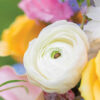The Floral Marketing Research Fund along with Asocolflores recently conducted a study on Consumer Preference for Flowers as Gifts. You are more than welcome to read the entire 44 page report on the findings…if time is of the essence, check out the Top 15 Key Insights posted below the press release. There is some very valuable inormation included that you can apply to your every day business.
We would personally like to thank Debi Aker for sharing this information with us.
![]()
NEW Consumer Research Results released.
For Immediate Release
Contact: Debi Aker
info@floralmarketingresearchfund.org
(703) 838-5239
Quality of Flowers More Important to Consumers than Price
ALEXANDRIA, VA * November 29, 2010 – The Floral Marketing Research Fund (FMRF) has just released a comprehensive study on Consumer Preference for Flowers as Gifts. According to the study, the quality of flowers is more important to consumers than price. When compared with other attributes when purchasing flowers, consumers ranked quality the highest consideration in the buying process, followed by color, price, design, and other factors.
That’s just one finding from this comprehensive research study now available from the FMRF. Funded in part by Asocolflores and other industry individuals and organizations, this research provides important insight on how consumers perceive floral advertising, price, longevity, fragrance, appropriateness of flowers for specific occasions and other preferences.
The “Consumer Preference for Flowers as Gifts: Age Segments, Substitutes, and Perceived Risks” is the result of a two-year project funded by FMRF, which was conducted under the guidance of Chengyan Yue, Ph.D., at the University of Minnesota, with support from Bridget Behe, Ph.D., Michigan State University, and Charlie Hall, Ph.D., Texas A&M University.
“Our industry needs to be aggressive in seeking ways to bring our beautiful product to more people and to make sure we understand who our future customers are and what is important to them,” says Paul Bachman, of Bachman’s Inc., in Minneapolis, and chairman of the FMRF. “The Floral Marketing Research Fund is dedicated to addressing these extremely important marketing questions, and we are excited that Dr. Yue’s research hit the bulls-eye in what we hope will be an ongoing program directed at critical marketing topics.”
Reports can be downloaded from the FMRF website – www.floralmarketingresearchfund.org
The Floral Marketing Research Fund was established in 2008 by volunteers of the American Floral Endowment board of trustees to support consumer research that benefits the floral industry. For more information, contact the FMRF at info@fmrf.org.
Top 15 Key Insights:
1. Annually, people gave birthday gifts the most often and spent the most money on birthday gifts. However, many participants felt plants/cut flowers were not as suitable for birthdays as other gifts.
Ø There is great potential to enlarge the flower market through educating consumers about the suitability of floral gifts for occasions such as birthdays.
Ø Pair cut flowers and plants with perceived suitable gifts such as CD/DVD/books or gift cards can attract more consumers.
2. Longevity was a big concern and people wanted to know how to improve longevity. Most people’s expectation for cut flower longevity was 6 to 10 days.
Ø Promote and label flowers whose longevity exceeds people’s expectations.
Ø Labeling longevity of different cut flowers gives consumers reasonable expectations which can alleviate consumer post-purchase disappointment.
Ø Provide labels of care instructions or tips at purchase to help consumers increase flower longevity.
3. Many consumers were very sensitive to price. The middle group (31-40 year olds) was especially pressed by budget. Consumers felt the price of flowers was the second most unreasonable with DVD/CD/Books ranking the first.
Ø Frequent buyer clubs or punch cards, first time purchaser discounts, free filler, greens or vases, or free delivery within X miles, all offer a way for florists to increase consumer visits and purchases.
4. Depending on specific non-calendar occasions, the spending limit on floral gifts ranged from $18 to $35, with birthdays having the highest spending limit, followed by get well and congratulations.
Ø Pricing floral gifts under spending limits can increase consumers’ likelihood of purchasing them as gifts and enlarge the market.
5. Consumers indicated they saw advertisements of flowers the least compared with other gifts and they only saw advertisements for big holiday occasions.
Ø Year round advertisements of flowers can educate consumers that flowers are NOT just for big holiday occasions.
Ø Advertise cut flowers and plants as gifts to the target market with the most effective and efficient mode of advertising: for 18-30 year olds, advertise online, YouTube, Facebook and sidewalk signs, for 31-40 year olds, advertise on radio, billboards, online and company vehicles, for 41-50, advertise primarily on radio, in magazines and newspapers.
Ø To expose the company/product to the maximum number of people, television commercials or internet ads are the best. However, many people ignore commercials and internet pop-ups due to focusing on specific shows/searches.
Ø Add humor to improve notice and memory.
6. Most participants got their gift ideas from searching merchandise/in store displays and asking friends or family.
Ø Develop attractive in store displays and exhibit them at different stores.
Ø Create word of mouth that floral gifts are wonderful gifts for any occasion.
7. A great interest was expressed by many consumers about general cut flower and plant knowledge, symbolism and meanings.
Ø Not many consumers, especially young consumers, have a lot of experience with cut flowers/plants. Provide information sheets/labels of meanings, symbolism and histories at purchase or online. Educational advertisements are useful as well.
8. In close and casual relationships, cut flowers were the second least risky gift behind gift cards.
Ø Promote cut flowers as a low risk gift. Have information on meanings available to help reassure customers of the message they want to convey.
9. The most important flower attributes were bloom quality, color, price, design, longevity, availability, fragrance, uniqueness, ease of care, and packaging/container.
Ø Advertise and stand behind the quality, offer many colors at reasonable prices, have fragrant/unique flowers available, have easy care instructions, and have the flowers/plants in attractive/unique/fashionable packaging. All of these actions will improve customer loyalty and increase sales.
10. People did not like having excess vases. They wanted to spend their money on the flowers not the vase. Often, people had many vases from previous bouquets but vases were not stand alone decorations.
Ø The industry can develop vases that are disposable, biodegradable, returnable or recyclable or give a ―ring your own vase‖option.
11. Many participants used national floral websites but few utilized local florist websites.
Ø Improve local florists’ websites’ professionalism, speed and photos to increase use and convenience.
Ø Offer free shipping within X miles of the store on internet purchases.
Ø Have easy to follow directions, hours, and contact information to decrease customer frustration.
12. Online ordering was used by younger (18-40 year old) consumers but often mistrusted.
Ø Create a quality assurance plan.
Ø Take a digital photo and e-mail it to the giver prior to delivery.
13. Most participants enjoyed receiving flowers, agreed that flowers cheered them up, and felt flowers can convey many messages. People wanted to give gifts that their friends will like; however, young consumers felt their friends do not like receiving flowers as much as other gifts.
Ø Promote flowers as a great year around gifts.
Ø Market cut flowers and plants as suitable gifts that are enjoyed by younger consumers.
Ø Promote their benefits of mood enhancement and bringing cheer.
14. Data has shown that as people got older they were more likely to perceive cut flowers/plants as reflecting their personality. CD/DVD/books and gift cards were perceived as reflecting younger group’s personalities. Gift cards reflected the middle group’s personalities, and plants and cut flowers reflected the older group’s personalities.
Ø Give consumers the ability to personalize their floral gift through unique packaging, vases, and pairing them with other gifts.
15. In the younger group 29% could not name their favorite flower versus 11% in the older groups could not, meaning young consumers were less knowledgeable about floral gifts. For all groups, roses were the top choice.
Ø Help young consumers reach outside their comfort zone (using only roses) and discover different types of flowers that express their personalities better.




